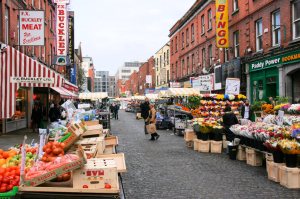Food trucks, farmer’s markets, street vendors, etc.; all of these rebel against sterile suburban environments. They are inherently opposed to the strict separation of land uses and streets designed solely for use by the automobile.
When viewing a community as an organism, drivable suburban environments, void of interaction, provide a culturally and socially unsustainable future. The human spirit is denied the ability to fully express itself in these environs, thus preventing an organic evolution of local cultures not primarily influenced by televised popular culture. While these may be issues that would be better addressed by cultural geographers and sociologists, their causes are found in the way we design our cities.
During the early 20th century, the dominant opinion of how a street should be designed changed from one of a “socially diverse pluralistic conception,” which facilitated multiple uses and modes of transport, to one of “a modern unitary reality,” designed for speed and efficiency, heavily influenced by the modernist vision of urbanist Le Corbusier. His appeal to the spirit of industry and sterility certainly was embraced by many; however, one cannot easily escape the weight of moderation, and as urban design regains its footing and reacquaints itself with the other equally powerful needs and desires of people, such as aesthetics, passion, and a sense of place and cultural identity, we are rediscovering core principles of city life that have been forgotten by many.

We, as urbanists, must take the city from the machine and give the city back to the people. To do that, in addition to adopting traditional design principles, municipalities must decriminalize the use of public space by allowing people to use it; they paid for it and built it. When city officials enforce strict patterns of formal commerce and street decorum shared by a vocal and influential few, the lack of energy and interaction amongst people is clearly evident to an observer.
By allowing and encouraging people to use the street for more than just commuting, primarily through traditional urban design principles, but also through municipal regulations, cities will be able to drop the plastic façade of sprawl and won’t have to hide their citizens from themselves. A re-introduction between people and the American city is needed. People are imperfect, as is the city; it would be dishonest to attempt to mold each other into something they are not. Rather, we must embrace those differences and understand that we need each other’s imperfections to function and grow.

Once we open the city to our depressed economies by welcoming the street vendor, the food truck, the musician, and the artist, we will be able to provide the opportunity for successional growth from sidewalk to stand to storefront. Successional growth is key to fiscally stable and sustainable communities. While there are many successful examples, too many New Urbanist town center developments are under-utilized because of lack of demand. The same concept of “build it and they will come” that is so prevalent in suburbia has driven the development of many of these new town centers, creating empty public spaces and sidewalks. For a planner to ignore the logical metamorphosis of a town is lazy. The informal market acts as a litmus test of the community; it allows the planner to visualize developing demand for certain services and products in certain areas, and provides a buffer in the balancing of supply and demand. If demand is more than supply, the informal market can meet the extra demand until a more formal solution is provided.
In many parts of the developing world, the informal market makes up more than half of the job market. In the mid 1920’s, New York City “pushcart peddlers sold nearly 50 million dollars’ worth of food and merchandise annually,” making up between 25% and 40% of the produce market share. Potential vendors might not be able to afford the rent of a traditional brick and mortar storefront at first and are thus discouraged from setting up shop. Cities often invest in building incubator space by refurbishing abandoned warehouses, etc., but are missing a much more affordable and accessible opportunity with allowing and encouraging expanded use of the street to include vendors and the like.
Tactical Urbanism is a popular movement that has gained significant attention recently. Its approach is mainly one of a small scale reclamation of public space. It serves as a conduit for the re-emergence of interest in the informal; several steps in the right direction. As the movement and attitudes of city administrators evolve, it will ideally be adopted by a general informal urban culture, become less subversive, and more market driven.
Allowing people to participate in commerce on the street has been part of the urban experience for thousands of years, until the rise of the singular view of the street solely for the car. The market was the genesis of the city, it was the justification for its existence, and it was the impetus behind expansion. To prevent people from accessing the market, and only designing for the car, is to sterilize the petri dish that the city is meant to be. The informal use of public space should be as much a priority of New Urbanist design as the Transect. The human experience thrives in such conditions.
– Eric Pate

Come to Dobbs Ferry on October 5th and see the informal in its full glory. Saturday is our 11th annual Ferry Festa. Food trucks, farmer’s markets, street vendors, etc.